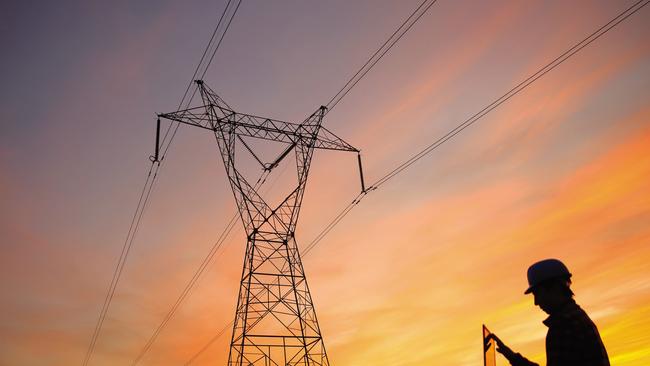NSW underwriting plan sparks power struggle
A fresh battle has been sparked over Australia’s power grid with a NSW government scheme to underwrite renewables worrying big producers.

A fresh battle has been sparked over Australia’s power grid with a NSW government scheme to underwrite renewables worrying big producers nervous over more state-based intervention, while EnergyAustralia has proposed a redesign of the Morrison government’s reliability rules to ensure new electricity generation is built.
Big energy producers and users have raised fears over a plan by the NSW government to underwrite investment in renewable and storage generation but clean energy operators backed the move as the right signal to allow the state to move more smoothly from coal to renewables.
The Australian Energy Council — which represents the big three of AGL Energy, Origin Energy and EnergyAustralia — said the NSW move would detract from a national approach already under way.
“Any government underwriting of specific generation projects has the potential to distort market signals for private generators by protecting new projects from low prices. The market is designed to intentionally put risks on investors rather than consumers,” AEC chief executive Sarah McNamara said.
“The NSW-specific reliability target being imposed under this plan is excessive and along with the underwriting may lead to an overbuild of energy assets in NSW.
“This would ultimately mean higher costs for households. Given the interconnectedness of the power system, energy reliability is best managed at a national level rather than state-by-state.”
The policy aims to lower household power prices by $130 a year and incentivise investment in renewable energy zones by providing low-cost financing options, independently assessed to prevent cost overruns.
The Victorian government has also broken away from a national approach after changing the state’s electricity act, adding more transmission and storage generation, including a giant battery, to ensure it doesn’t get caught short when coal plants close.

The Energy Users Association, which represents large power and gas consumers, said it was worried about NSW following the same path.
“The EUAA has expressed concern that the NSW Electricity Infrastructure Roadmap is another example of a state government taking independent action instead of working to consolidate a nationally consistent approach to energy policy,” EUAA chief executive Andrew Richards said.
“We understand the pressure to keep the lights on, but we urge state governments to remain committed to building a nationally consistent energy policy that avoids unnecessary duplication of stakeholder effort and the introduction of competing policy and regulatory frameworks that may lead to increased costs and inefficient allocation of resources.”
NSW’s biggest power user, the Tomago aluminium smelter, backed the plan drafted by the state’s Energy Minister Matt Kean.
“Anything that delivers cheaper, cleaner, more reliable energy is clearly of interest to a large, energy-intensive manufacturer such as ourselves,” Tomago chief executive Matt Howell told The Australian.
“We look forward to working with the NSW government to understand more about the detail behind the plan and how we might engage with it.”
The Clean Energy Investor Group — with $9bn of assets under management including Blackrock, Macquarie and UK developer John Laing — also applauded a greater focus by governments on developing Renewable Energy Zones.
“This focus on reducing the cost of capital for new renewable energy projects, enabled by long-term contractual support, is key to enabling investors to deliver the low-cost capital required to help NSW achieve the clean energy transition in a cost-efficient way which also protects consumers,” CEIG chair Simon Corbell said.
Separately, a blueprint for Australia’s national electricity market by the federal government’s Energy Security Board has proposed a series of reforms as part of a redesign of the electricity system from 2025, aimed at ensuring a smooth transition to renewables as coal plants retire.
Potential solutions to ensure enough generation is in place could involve removing a trigger for the Morrison government’s Retailer Reliability Obligation and instead making it a permanent obligation for electricity companies to guarantee dispatchable power for businesses and consumers.
However, EnergyAustralia said a completely new mechanism had to be introduced to ensure enough investment in new supply.
“Governments need to enable generation investment, not build it themselves. As private investors we work within the market design to take responsibility for reliable supply, and to assure the community that new assets will be connected to the system by the time they are needed,” EnergyAustralia said.
“The market design needs to give governments the confidence to not intervene in this process, while at the same time sending signals to encourage investment.”
Concerns have been raised by investors that market prices are too low to justify bringing new “firm” power supplies into the grid while the potential for fresh government intervention also continues to weigh on sentiment.
The power giant has proposed a scheme called the resource adequacy mechanism which would involve power retailers buying advance contracts that ensure the physical delivery of supply when there is a risk to reliability.
Coal, which provides 70 per cent of electricity, will contribute less than a third of supply by 2040 and could be forced out earlier than planned as competition from renewables and carbon constraints render plants uneconomic.





